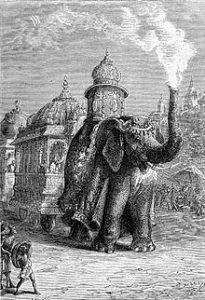
I’m delighted The Gallery of Curiosities has chosen to reprint my story, “The Steam Elephant” in their Summer 2018 Issue (#3). It gave me a chance to re-read the story, and recall the fun I had writing it.

“The Steam Elephant” is my sequel to Jules Verne’s novel The Steam House. In Verne’s tale, a British inventor constructed a steam-powered mechanical elephant (and two wheeled carriages towed behind it) on commission from an Indian rajah. This rajah died before taking possession, so ownership remained with the inventor. He took a group of British friends, a Frenchman, and several servants, on a series of adventures in the wilds of India.
My steampunk sequel picks up eleven years later. Although the original steam elephant met its end in Verne’s novel, the engineer constructed a second one in my tale. He modeled this new elephant after the African species. The group of friends gathered again, this time to go lion hunting in Africa, but found themselves drawn into the Anglo-Zulu War of 1879.
Verne’s story predated automobiles and appeared long before Recreational Vehicle motorhomes, when people only knew about steam locomotives on rails. I’m sure it fascinated his readers to imagine taking their home with them while travelling. Today, millions of people do just that…but they’re restricted to travelling on roads. Verne’s elephant walked anywhere, even through shallow rivers.

As an engineer, I loved the idea of a quadrapod, animatronic, bio-inspired walking vehicle powered by steam. This lay well beyond the technology of the Nineteenth Century, and we’re only at the early stages of such mechanisms today. That’s why the AT-AT ground assault combat vehicles of Star Wars seem so cool. By the way, the AT-AT designers also drew inspiration from a pachyderm.
Verne described the elephant as being a ‘traction engine,’ a steam engine that pulls loads on roads or smooth ground. This term doesn’t find much use today, since internal combustion gasoline engines supplanted steam for tractors and other off-road vehicles.
Still, imagine owning such an elephant. Within its iron flanks, there’d be the water reservoir, fuel storage, firebox, boiler, and cylinders common to locomotives. Also, you’d find the massive gears and linkages necessary to move the four giant legs in a stable pattern.
Seated in your well insulated howdah on top, you’d rotate the trunk down to pump in water from a river. Then you’d swivel the trunk up, start the engine, sound a blast from its trumpeting whistle, and watch steam and smoke belch from the trunk. When you pushed a lever, your elephant would plod forward on its ponderous legs over any type of flat ground or shallow water. Roads? Where we’re clomping, we don’t need roads.
Perhaps after ten minutes of sweating through that, you’d retreat to one of the towed carriages and let someone else drive the elephant while you sipped wine and played whist.
I’ll take two of those, please. In a way, I did. I wrote about one in another story,  “Rallying Cry.”
“Rallying Cry.”
Too bad you can’t buy your own steam-powered, mechanical elephant vehicle. You could try to build one for several thousand dollars. Or, the next best thing, you could lay down just $3.00 and get a copy of The Gallery of Curiosities magazine, issue #3, and read “The Steam Elephant” by—
Poseidon’s Scribe
